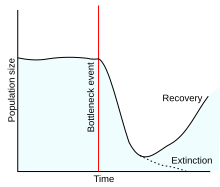From Wikipedia, the free encyclopedia
A population bottleneck is a sharp reduction in size of a population due to environmental stochastic events (such as earthquakes, floods, fires, or droughts) or human activities. Such events are able to reduce the variation in the gene pool of a population drastically, because when the population was close to extinction, the few left passed on those genes to their offspring, which became mostly dominant over the generations. If there are not enough individuals left, or the ones that survived are not able to reproduce sufficiently to re-form the species population, that population may go extinct.[1] In consequence of such population size reductions and the loss of genetic variation, the ability of a population to adapt to prevalent environment or selection like climatic change or shift in available resources is reduced. However, depending upon the causes of the bottleneck, the survivors may have been the most fit individuals, hence improving the traits within the gene pool while shrinking it. This genetic drift can change the proportional distribution of an allele by chance and even lead to fixation or loss of alleles. Due to the smaller population size after a bottleneck event, the chance of inbreeding and genetic homogeneity increases and unfavoured alleles can accumulate. Thus, an ecological bottleneck can lead to a genetic bottleneck, in which the genetic variation within a population and the potential to adapt to a changing environment decrease.A slightly different form of a bottleneck can occur, if a small group becomes reproductively (e.g. geographically) separated from the main population, for example through a founder event. Population bottlenecks play an important role in conservation biology (see minimum viable population size) and in the context of agriculture (biological/pest control).[2]
Contents
Examples
Humans
The Toba catastrophe theory suggests that a bottleneck of the human population occurred c. 70,000 years ago, proposing that the human population was reduced to perhaps 10,000 individuals[3] when the Toba supervolcano in Indonesia erupted and triggered a major environmental change. The theory is based on geological evidences of sudden climate change and on coalescence evidences of some genes (including mitochondrial DNA, Y-chromosome and some nuclear genes)[4] and the relatively low level of genetic variation with humans.[3]However, such coalescence is genetically expected and does not, in itself, indicate a population bottleneck, because mitochondrial DNA and Y-chromosome DNA are only a small part of the entire genome, and are atypical in that they are inherited exclusively through the mother or through the father, respectively. Most genes in the genome are inherited from either father or mother, and thus can be traced back in time via either matrilineal or patrilineal ancestry.[5] Research on many genes finds different coalescence points from 2 million years ago to 60,000 years ago when different genes are considered, thus disproving the existence of more recent extreme bottlenecks (i.e., a single breeding pair).[3][6]
On the other hand, in 2000, a Molecular Biology and Evolution paper suggested a transplanting model or a 'long bottleneck' to account for the limited genetic variation, rather than a catastrophic environmental change.[7] This would be consistent with suggestions that in sub-Saharan Africa numbers could have dropped at times as low as 2,000, for perhaps as long as 100,000 years, before numbers began to expand again in the Late Stone Age.[8]

No comments:
Post a Comment